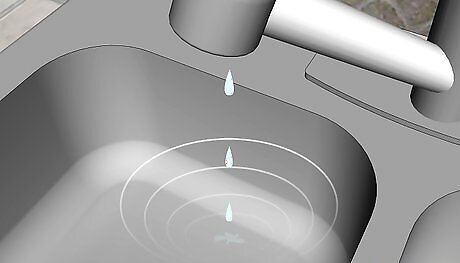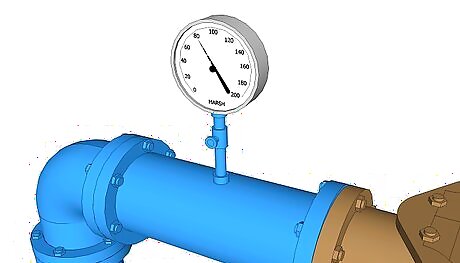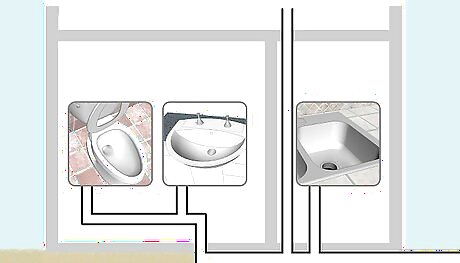
views
High water usage (or water bills)

Listen for dripping sounds. As simple as this step may seem, it may be overlooked in a busy, noisy home. Even though a dripping faucet may not seem to waste significant amounts of water, over the course of day, each individual drop adds up to thousands and thousands of drops, or gallons and gallons of water. Choose a time when there is little or no activity, such as early in the morning, or late at night, when the house is very quiet.

Look for evidence of a leak along the base board of walls near the location of your plumbing fixtures. Pipes that contain water under pressure can become corroded, develop loose fittings, or crack because of freezing, allowing a continuous loss of water until repaired. Mildew or mold, darkened surfaces, or even puddles of water may occur below leaks. If the problem is inside the wall cavity, it may be necessary to remove the paneling, plaster, or wallboard to correct it. Pipes also may sweat when cold water passes through them in warmer interior air-spaces in the home, and this water condensing on the surface of pipes may drip, causing moisture problems to appear where no leak exists.

Look under vanities and sinks for drips or similar evidence noted in the previous step. Use a flashlight to follow the path of exposed pipes, looking for droplets of water that will accumulate at the lower section before dropping off, and run your fingertips along these pipes to feel for wetness.

Listen for noises from your commodes/bathrooms, to determine if they are running at unusual intervals, when no one has recently flushed them. When there is a seal leak in the water closet (toilet), the tank will drain slowly over a period of time, until the water level drops sufficiently for the float valve to open and replenish it. Sticking flush valves and leaking seals in toilets can waste a lot of water, since, like dripping faucets, the flow, although perhaps very small, is continuous. Check the supply valves on lavatories and commodes if they are leaking. The packing, which seals the valve stem of a typical stop (water valve) seals when compressed just enough to "pack off" leak paths, but not so tightly that turning the handle is difficult. Turn the packing nut (top nut surrounding the stem) slightly clockwise (shouldn't require more than 1/8 turn or so) and see if this stops the leak around the stem. Supply valves are meant to be fully opened or completely closed. Turn the valve off by turning the handle clockwise until it stops. Open the valve by turning the handle counter-clockwise (anti-clockwise) until it stops. Occasionally, a very slight leak of a stem will stop if the valve was partly opened and is either fully closed or opened fully. See also How to Fix a Running Toilet and How to Fix a Slow Toilet.

Check your water meter. Municipal water systems use a meter to measure the amount of water used, and by turning off all faucets and appliances that consume water, the flow to your home will cease. Locate your water meter, read the amount displayed, note it, then wait an hour or two, and reread it to see if water has gone through it when none was being used in your home. Very small leaks will not appear to move the meter over a short period of time, so these will be harder to detect using this method.
Drain/waste problems

Identify the problem that is occurring with your drains, specifically, the individual drains which are not functioning correctly. Some typical problems are these: Slow sink or tub drains. Water backing up in the bathtub, shower, or sink. Wet areas in walls or along floors in rooms adjacent to walls containing drain pipes. Wet areas in the lawn near drain piping. Unusual gurgling or bubbling sounds when water is draining.

Try to determine the extent of your "slow drain" problem. If it is isolated to only one sink or other fixture, it is probably localised to the individual pipe that connects that fixture to the main line. In other words, if only the kitchen sink drains slowly, the problem is in the sink trap or drain line that connects to the larger pipes which additionally carries water from other sinks, the commode, and the bathtub.

Determine the route the waste water takes to reach the main drainpipe. Many times, the individual drain pipes are routed though the wall cavity, interconnecting to other pipes, which then go below the floor and exit the home to either the septic system or sanitary sewer.

Flush the drain which is not operating like it should with very hot water. For a bathroom or kitchen sink, this can be done by stopping the drain and filling the sink with hot water from the faucet. Unstop the plug, and the water will drain into the material which is clogging the pipes, and it the material is a residue of grease or grease like waste, the hot water may dissolve it sufficiently to flush enough of it out the pipes to restore your flow. If necessary, use a drain cleaning product containing chemicals to dislodge or dissolve the material that is causing the stoppage. Drano or Liquid -Plumr are examples of chemical products that may dissolve hair, soap residue, grease, or other materials which can clog a drain line. Be careful if you choose to use a plumber's snake to open a clogged drain. These can be very messy, and may compact the material that is clogging the pipes, making it even more difficult to remove, if the proper technique is not used. See also How to Unclog a Toilet and How to Unclog a Bathtub Drain and How to Unclog a Kitchen Sink.




















Comments
0 comment